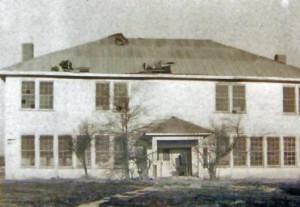I wonder how many towns throughout the United States have a College Street but no college? College Street in Sulphur Springs is on the north side of the courthouse, but where and what was the college when the courthouse was built? College Street in Greenville runs north and south until it intersects with West Lee Street. Originally it was the east boundary of the Burleson College Campus. My hometown of Jacksboro has a College Street in the old part. It was only a couple of years ago that I realized the college existed for only one year in the 1890s.
My latest count reveals seven colleges were in existence between 1885 and 1930 here in Hunt County. In alphabetical order they were Burleson College, Calhoun College, Elmwood Institute, Henry/Emerson College, Mayo College, Peniel/Texas Holiness University, and Wesley College. Of course, many of these old schools changed names and locations through their history. Mayo College is the only one extant. We know it today as Texas A&M University Commerce; but many alumni still call it East Texas State University. Five of the seven have historical markers. Elmwood Institute in Celeste and Calhoun College in Kingston do not.
Calhoun College appears to be the oldest, although there were short-lived schools earlier in both Greenville and Commerce. The term “college” was loosely used in the late 19th and early 20th centuries. It usually included an elementary department, the academic department that would be called high school or prep school today, and the actual college. The first president or superintendent at Calhoun was F. S. Sligh. His wife and her sister were on the faculty and descendants of South Carolina Senator John C. Calhoun, hence the name Calhoun College. For most of its twelve-year existence, Professor T. E. Wallis was president.
Contemporary descriptions called Calhoun College “progressive” and a leader in the field of education. At that time, “progressive” meant high principles and ideals. It was said to be an inspiration for students to seek greater advantages in learning.
Wallis was considered an intellectual giant among his fellows. He taught seven languages, was a superior mathematician, with a store of general knowledge. He was described as a man of homelike simplicity, freedom from arrogance, whose modesty and reserve were as marked as his superiority of mind. The teachers he chose portrayed the same mental and person qualities. The music teacher, Miss Roberta Strain, was said to be a graduate of a conservatory in New York. Art and drama teacher, Mrs. J. S. Bolton, was a graduate of a school in Boston.
Calhoun College had three flourishing literary societies, The Irving, Philomathean, and The Alcott. The first and last were named for American writers of the century and the middle is still a literary society on some college campuses. The author of my source material must have been a member of The Irving Literary Society because that is the only one with in-depth information provided.
The Irving Literary Society at Calhoun owned and controlled the library, said to be a good collection of standard works. The society also published a newspaper quarterly, “The Irving Review”, one of the few schools to do so at that time in North Texas. Students wrote and edited each issue that was printed by either of the Greenville papers.
Calhoun College closed in Kingston with the death of Professor Wallis in 1897. It just so happened that was a time of extreme drought and economic hard times when the price of cotton dropped very low. When the Santa Fe Railroad laid tracks across the northern part of Hunt County, Kingston was by-passed for the new town of Celeste. The next year, most of the Calhoun faculty joined the new Elmwood Institute. That however, is a story for another time.

